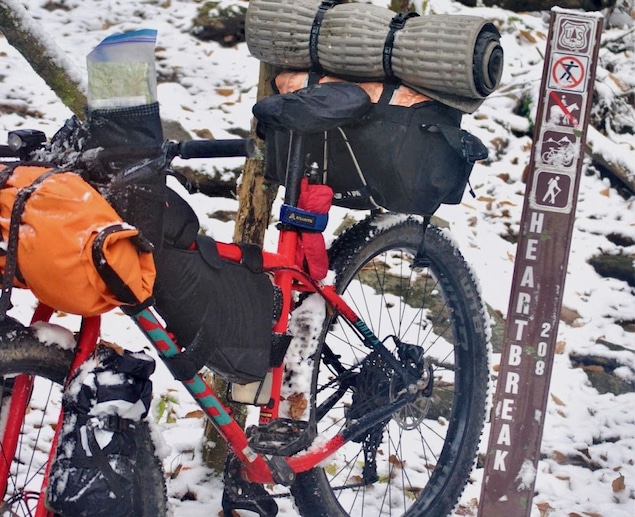Consider what it is you like best about the Appalachian Trail or the Pacific Crest Trail, and then ask yourself this question, keeping in mind that, hypothetically, you were born decades earlier than you really were:
Benton MacKaye, the father of the Appalachian Trail — or perhaps Clinton Churchill Clarke, who conceived the notion of the Pacific Crest Trail — have asked you to scout the proposed routes to help with the writing of a guidebook.
Would you do it?
“Yes please,” would be my immediate response.
Granted, it’s a little late to do original onsite research for those two hike-thru heavens, but let’s move ahead to the 21st century and Logan Watts. A decade ago, from his home in the mountains of North Carolina, Logan launched a website called Pedaling Nowhere, which has since become BikePacking.com — a site has garnered an enormous following.

(If you’re unfamiliar with the term or activity, according to the editors of BackPacking.com. bikepacking is the “synthesis of all-terrain cycling and self-supported backpacking. It evokes the freedom of multi-day backcountry hiking and travel off the beaten path, but with the range and thrill of riding a nimble bicycle. It’s about venturing further into places less traveled, both near and far, via singletrack trails, gravel, and forgotten dirt roads, carrying the essential gear, and not much more.”)
Getting to Know Bikepacking.com
BackPacking.com started out as a place to share bikepacking stories, product review and profiles of people, their bikes and the routes they were riding, and by 2014, as more and more routes were catalogued, readers looked forward to everything from challenging and life-changing expeditions to day trips that, by the way, can also be life changing.
Bikepacking’s following grew to a point where a print journal — The Bikepacking Journal — was launched (which is now published in April and October of each year), and bikepacking “collective” was formed, which has grown to have enormous influence on the bike industry.
Many of the routes you can find on the website were originally published by
Bikepacking Collective members or Bikepacking.com’s internal route experts. But, as Bikepacking.com’s community began to expand — more like explode — more and more reader submissions appeared and routes spanning the globe began to appear online.
Just sign on to the BikePacking website and click on a route. You’ll discover any type of route you desire on the site. Each is designed and named by readers, as well as by the core editorial team that includes Logan Watts, Lucas Winzenburg, Cass Gilbert, Miles Arbour, Joe Cruz, Virginia Krabill, and Neil Beltchenko.
Personally, at first, I found it frustrating to explore the website. I’d see a trip report and want to go ride it. Then I’d see another report and want to ride that too. I found myself constantly working on my own routes and exploring solo or with family.
And then I realized I was getting route fever. Fortunately for myself and my family, we really don’t want to ride other people’s routes. Instead, I read about the ones that interest me, look at where the route goes, and then look at how I can use that information to create my own personal bikepacking routes.
While I’m definitely inspired by others’ routes, I don’t necessarily want to follow in their footsteps — or their pedal strokes for that matter.
Introducing the Eastern Divide Trail
That all changed when I started hearing murmurs, whispers, and then articles about the proposed “Eastern Divide Trail” (the EDT), which is comprised of 5,000-plus miles of mostly off-road riding. It’s a bikepacker’s dream!
Bikepacking.com contributors and the folks running The Bikepacking Journal started stringing together trails and trails systems down the East Coast to create a trail that will run from Canada to Key West Florida.
For years, the Appalachian Trail has been the only real off-road corridor to span the East Coast of the United States. But as much as people love the AT, it’s really only for hikers, and it has become increasingly crowded, testing its own carrying capacity.
As a result, the concept of an Eastern Divide Trail was conceived, linking the two great Eastern Continental Divides. But unlike the legendary Appalachian Trail, the EDT would accommodate both bikepackers and hikers, with trail towns found outside areas now served by the AT with food, lodging, shops, and shuttle service. The Eastern Divide Trail has the potential to bring some of those benefits to other communities along the route.
The potential for riders in the East will be tremendous. Ride the trail, visit cities. Get back on the trail, repeat.
On a personal note, I have already ridden sections of this route. It will have a variety of terrain and a variety of challenges for riders. On some days riding will be flowy and dreamy, and on other days you may find yourself “hike-a-biking,” and wondering why you didn’t decide to just backpack. But whatever the route dishes out, it’s bound to be an adventure.
Pretty soon, I’m planning to pack up my bike and head out onto Section 6 of the EDT, which runs from Damascus, Virginia to Mulberry Gap, Georgia. I’m expecting cold nights, days with short light and plenty of opportunities to find beauty. And I’m definitely looking forward to it.
TALK TO US
Have any further questions about our courses, what you’ll learn, or what else to expect? Contact us, we’re here to help!
Leave a comment